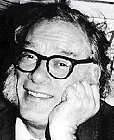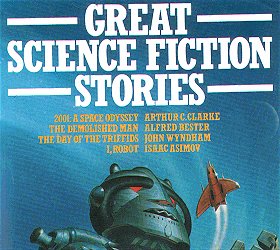
|

 I, ROBOT by Isaac Asimov (hier online bestellen)
I, ROBOT by Isaac Asimov (hier online bestellen)
The story:
In this collection, one of the great classics of science fiction, Asimov set out the principles of robot
behavior that we know as the Three Laws of Robotics:
1. A robot may not injure a human being, or, through inaction alllow a human being to come to harm.
2. A robot must obey the orders given it by human beings except where such orders would conflicht with the first law.
3. A robot must protect its own existence as long as such protection does not conflicht with the First or Second Law.
Here are stories of robots gone mad, mind-reading robots,
robots with a sense of humor, robot politicians, and robots who secretly run the world, all told with
Asimov's trademark dramatic blend of science fact and science fiction.
This is not merely one story, but a collection of stories taken from eras of time from 1998 to 2059.
The book is set with the premise of a reporter interviewing one of the head 'robopsychologists' at
US Robots and Mechanical Men, Inc.(Susan Calvin). She tells of many of her and her fellow scientists' encounters with a
runaway 'lost' robot, a mind-reading robot, a practical jokester robot, and a robot named Cutie
(he thinks himself a prophet, so unconvinced is he by the notion of his subservience to humankind) , who
refuses to believe that human beings created him and goes on to form a robot 'cult', recruiting other
robots who then proceed to bowdown and worship the self-proclaimed 'prophet'. Although written over
50 years ago, Isaac Asimov gives great insight into the future world of science and culture that we can
only imagine.
'I, Robot' is a critique of the social pessimism and all pervading anxiety that holds back potentially beneficial advances.
Extract from book:
... The Talking Robot was designed to answer questions, and only such questions as it could answer had ever been
put to it. It was quite confident of its abilitiy, therefore, 'I - can - help - you.'
'Tahnk you. Mr Robot, sir. Have you seen Robbie?'
'Who - is Robbie?'
'He's a robot, Mr Robot, sir.' She stretched to her tip-toes. 'He's about so high, Mr Robot, sir, only higher, and he's very nice.
He's got a head, you know.I mean, you haven't, but he has, Mr Robot, sir.'
The Talking Robot had left behind, 'A - robot?'
'Yes, Mr Robot, sir, . A robot just like you, except he can't talk, of course, and - looks like a real person.'
'A - robot - like me?'
'Yes, Mr Robot, sir.'
To which the Talking Robot's only response was an erratic splutter and an occasional incoherent sound. The radical
generalization offred it, i.e. its existence, not as a particular object, but as a member of a general group,
was too much for it. Loyally, it tried to encompass the concept and half a dozen coils burnt out. Littlewarning
signals were buzzing.
(The girl in her mid-teens left at that point. She had enough for her Physics 1 paper on 'Practical Aspects of
Robotics'. This apper was Susan Calvin's first of mayn on the subject.)
About the author:
 Isaac Asimov is one of the three grand masters of science fiction with Arthur C. Clarke and Robert A. Heinlein.
Isaac Asimov is one of the three grand masters of science fiction with Arthur C. Clarke and Robert A. Heinlein.
He said abou himself:
"I received the fundamentals of my education in school, but that was not enough. My real education, the
superstructure, the details, the true architecture, I got out of the public library. For an impoverished
child whose family could not afford to buy books, the library was the open door to wonder and achievement,
and I can never be sufficiently grateful that I had the wit to charge through that door and make the most
of it." (from I. Asimov, 1994)
Asimov was born around January 2, 1920 in Petrovichi, near Smolensk, Russia, to a Jewish family that emigrated to the United States when he
was three years old. He grew up in Brooklyn, New York. His parents owned a candy store and everyone in the
family was expected to work in it. He saw science fiction magazines in the store and began reading them.
In his late teens, he began to write his own stories and soon was selling them to pulp magazines.
He graduated from Columbia University in 1939 and took a Ph.D. in chemistry there in 1948. He then joined the
faculty of Boston University, with which he remained associated thereafter, but in a non-teaching capacity.
B.U. ceased to pay him a salary in 1958, by which time his income from writing already exceeded his income
from his academic duties. (Asimov remained on the faculty as an associate professor, in 1979 promoted to
full professor, and his personal papers from 1965 onward are archived at Boston University's Mugar Memorial
Library, where they consume 464 boxes or 232 feet of shelf space.)
He married Gertrude Blugerman on July 26, 1942, with whom he had two children, David (b. 1951) and Robyn
(b. 1955). After an extended separation, they were divorced in 1973, and Asimov married Janet O. Jeppson
later that year.
Asimov died on April 6, 1992, having contracted HIV from an infected blood transfusion during heart bypass
surgery in 1983. He was survived by his second wife, Janet, and his children from his first marriage.
Buchdaten:
I, ROBOT by Isaac Asimov
Sprache: Englisch
Taschenbuch - 288 Seiten - Spectra Books
Erscheinungsdatum: 1. Juli 1994
Auflage: Mov Tie-in
ISBN: 0553294385
Preis: € 7,60
If you want to buy below collection of SF stories second hand (hardback - c. 700 pp.) (€ 15 incl. postage), send me an eMail
More works from the same author:
zurück zur Übersicht
|
 I, ROBOT by Isaac Asimov (hier online bestellen)
I, ROBOT by Isaac Asimov (hier online bestellen)
 Isaac Asimov is one of the three grand masters of science fiction with Arthur C. Clarke and Robert A. Heinlein.
Isaac Asimov is one of the three grand masters of science fiction with Arthur C. Clarke and Robert A. Heinlein.




